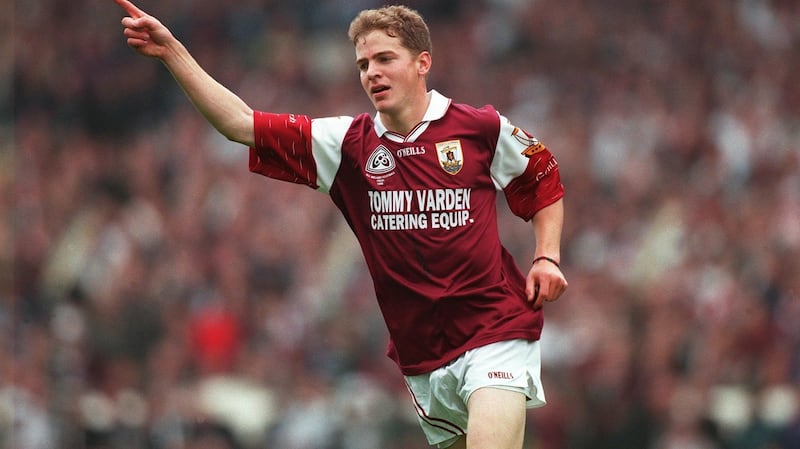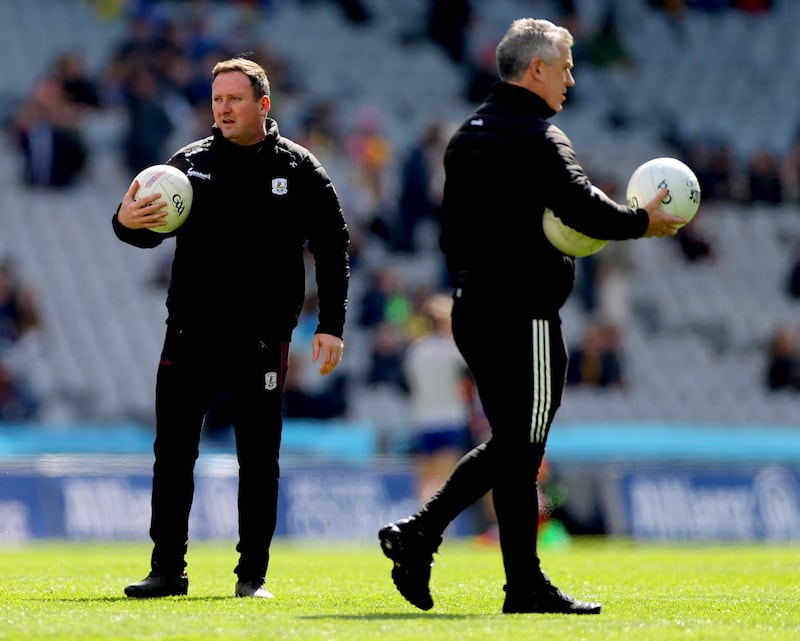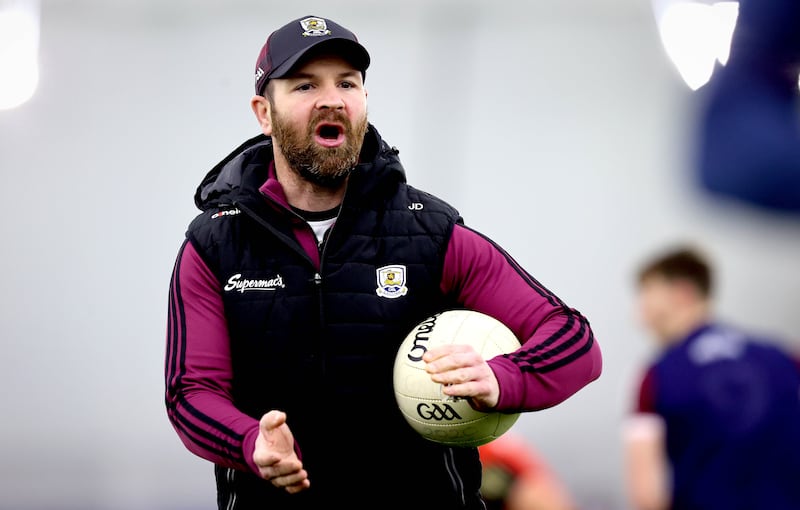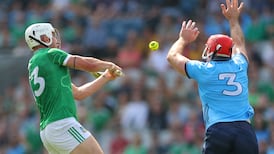It will always be a game of ghosts.
At a memorial mass a few years ago, the lifelong newspaperman Jim Carney fell into step with a Galway football figure who left the county mesmerised from the get-go.
Carney is one of the great voices and knowledge stores of this part of the world and he gets to know people easily. He had watched Michael Donnellan play for St Jarlath’s as a teenager and reported on him for years.
But as incandescent as Donnellan was on the field of play, he was brilliant at disappearing into the crowd as soon as the game ended. Carney had met him just once and fleetingly at that.
‘He counted himself blessed to be an Irishman’: Henry Mount Charles remembered at Slane
‘Crocodile’ fears see Jeff Bezos alter his Venice wedding plans
Leaving Cert grinds industry: ‘Salaries scales for the top teachers can be 100 to 250 grand’
Look inside: Fine four-bed Regency home in Sandymount just steps from the beach for €1.235m
Now they were heading up to the hotel but, because the day was so hot, they sat on a wall and chatted. About football, mainly.
“One of the best conversations I ever had in my life. He was an unbelievable judge, had an innate knowledge of players in every county. He talked and talked and talked and I shook his hand and said `Michael it was wonderful to meet you’. And I haven’t seen him since. I was half emotional about it.”
The conversation stirred up memories. Time is a goon: it’s hard for anyone to believe almost 30 years have passed since Pádraic Joyce’s 1994 St Jarlath’s team won a defining Hogan Cup for the Tuam school. It was an absurd team.
Joyce, Donnellan, John Divilly and the Meehan brothers would all start on the Galway team which stormed to the 1998 All-Ireland, ending a 32-year wait since the three-in-a-row team stopped in 1966.
Others of that Jarlath’s crew might well have been there. John Concannon was the acknowledged wizard of the college. And Carney reckons that Derek Reilly from Corofin, who played corner forward, was one of the most dazzling youngsters he ever saw play.
It was a time of riches in the draughty, famous old school and the ‘94 team played a central role in the winning of that breakthrough All-Ireland for Galway four years later.
Something about the year (the economy beginning to stir; Nokia phones becoming commonplace) and the gorgeous documentary by Pat Comer (A Year ‘til Sunday) seemed to straddle two eras; it was as though the hands of Galway’s post-war generation reached out to connect with the youngsters.
Michael Cloherty, who played midfield with St Jarlath’s team, made the All-Ireland squad in ‘98 having played minor and U-21 for the county.
“We had A versus B games and there was brilliant team spirit and a ferocious competitiveness,” Cloherty says now of that vital season under John O’Mahony.
“They were brilliant. The majority of the time the B team would get the better of the A team before upcoming matches. But then, there were another 10 or 12 boys knocking around the county who could have been in there to take the place of anyone on the panel.
“Like Derek Reilly, like John Donnellan, like John Concannon, like Francis McWalter. It can be small things – an injury at the wrong time. And there were a lot of lads disappointed because they could have slotted into the panel or the team. And Johnno always kept people fresh and honest and on their toes. The quality kept coming in and out of the panel in the years afterwards.”
Cloherty grew up in west Connemara and wanted to board in Tuam to give himself a chance to make the Galway minors. It worked. The school gave him all the football he could have dreamed of, with training three days a week. But they were on the field every day.
“The phrase was to go out ‘on stump’. For a kickaround. You’d hear, ‘Going out on stump made that fella.’
“As boarders you got to go out to the town twice a week. You would go downtown and meet up with the day boys or Mercy girls or whatever. So, we were interlinked with the town. There was the high walls but we would get to the shops. We were very much part of Tuam. We only got home every four weeks.
“The local boarders would get home on a Sunday but not those of us who lived further away. You have those friendships for years. And I think that helped with the overall psyche of the team. And with the spirit of the boarders. They were great supporters of the team.
“You had a sing song in the rec on the Saturday night of a big match. The first- and second-years would be fanatical looking up to the senior players. They had a camera club in the college with a little preview of the match, with interviews. You were living on the crest of a wave as the football season went on.”
Donegal’s John Haran landed down as a first year in 1989. He made the senior team as a substitute in 1994: another Letterkenny man, Kevin Winston, started at corner forward.
It was a big school, but the social order revolved around the football team and Haran quickly placed who was who. Divilly was a boarder. The Meehans boarded. Joyce was a day boy from Killererin; Concannon a day boy from Milltown. Tommie Joyce was a year ahead of them.
“Well, Concannon always stands out. He was the boy wonder. Even as a first year he was exceptional. Brilliant hands and skill. Joyce was a great player too and the Meehans were speedy. We were only young lads. But Concannon played on the senior team in third year, which is very, very rare. Only the exceptional players did that there.”
Donnellan was a year behind, starting in 1990.

“Michael came in with a massive reputation, even in first year. Maybe it was the name. And he would just get the ball and run past everyone in first year.”
It will take decades to gauge the psychic effect of the presence – and, since 2005, the absence – of St Jarlath’s boarding school on Tuam. The lowest recorded studentship was in 1845, when 17 students – one of whom, Ulick Burke, would become president of the college – made it through the winter on reduced food rations. The boarding enrolment peaked at 300, curiously, during the recession-ravaged 1980s.
Generations of big-boned sons of Mayo, Donegal and Galway tumbled through its walls. A glittering football reputation was its calling card. The senior team was feted.
The late great Tom Murphy, born and raised in Tuam, attended the local Christian Brothers School. He and his friends, teenagers in 1950s Ireland, regarded Jarlath’s with a combination of envy and suspicion.
“They just seemed to have it better,” he remembered in an interview.
“In my class at the CBS, there were 42 boys in the class and five of us managed to scrape a pass. We couldn’t all have been that stupid. St Jarlath’s also had an opera which was quite an event on the social calendar around Tuam.
“This was further evidence of their natural advantages – I had a reasonably good singing voice at that time but there was no place to exhibit it and impress the girls in the town. And there was an element of mystery about the Jarlath’s boys – they were only ever seen around town for a few hours on a Wednesday or a Thursday.”
These inequalities had largely evened out by the 1990s, when the concept of boarding was beginning to fade.
But 1994 was a perfect crossing point between past and future. Stan Shields, the well-known photographer, took a great black and white of a famous face in the crowd at one of their games. It was Seán Purcell, the Master.
Purcell had played on the Jarlath’s Hogan Cup-winning team of 1947, when snow fell in the west of Ireland from February through to May and half the school was stricken with influenza. Almost 50 years later, he was a genial supporter of the school team.
“He would always be knocking at the door and saying well done or, downtown you would meet him,” says Cloherty. “And in ‘98 himself and Tommy Varden would pop the head in the door of the Galway dressing room. He had a brilliant way about him for a man who was such a legend.”
And at Galway’s general media event last week, Joyce, unprompted, brought up Purcell’s name and made the same connection. The Purcell who greeted that ‘94 team was the opposite of a distant legend; a warm and approachable retired teacher, somewhere between a mentor and good luck charm. Jim Carney soldiered with Purcell for years, driving to games all over Ireland.
“I was over the moon,” he says when he heard that Joyce had brought his name up.
Why? Because Purcell’s name voiced by Joyce in 2022 provided a natural affirmation that there is some sense of kinetic energy about the whole show. Purcell was the day star of the 1964/65/66 Galway teams.
He formed with Frank Stockwell one of the most celebrated attacking partnerships in Gaelic games history. He played with John Donnellan, Michael’s father. When Joyce was in Jarlath’s, Frank’s son, Francis, was working as a caretaker and involved with football teams.
Now Joyce has gone from the whip-smart captain to family man in his mid-forties trying to help Galway burst through to the big time again. Invoking Purcell’s words came naturally to him. Because it is circular.
It should have been no surprise that when Joyce decided to get into management in a serious way he went back to the school to recruit his lieutenants, Divilly and Concannon.
“He obviously wanted people he knew and trusted around him,” says Haran.
Those leadership qualities were first identified in St Jarlath’s. Prior to 1994, the captain was always a boarder. Joe Long – the first non-priest to coach a Hogan Cup-winning team – broke the mould by selecting Joyce. Cloherty laughs at the idea that the teenage Joyce was basically just a younger version of the fast-talking, observant figure leading Galway this weekend.
“A younger version, yeah. He probably wouldn’t have been the most obvious choice for captain. And Joe Long obviously had the foresight and saw something in him as a footballer and an individual.
“He was a great captain. And then I was down in Tralee IT with him for a few years. I saw him develop playing Sigerson. We were living together. He had so much confidence then. Nothing fazed him. It was: he was just as good as any Kerry boy. He was developing as a player and a leader every year.”

That was always Joyce’s mantra about Galway, even in the post O’Mahony years when the county seemed to drift further and further away from All-Ireland contention.
He was always bullish about the quality in the county and about where the senior team should be. When you consider that early flush of high success to which they were exposed, it is understandable.
“There was pressure on Jarlath’s in 1994,” Jim Carney says. “They hadn’t won the Hogan Cup in a decade, and they had lost the finals of 1992 and 1993. As it turned out, that title came in a stroll, with a 3-11 to 0-9 win over St Patrick’s, Maghera. Donnellan set Kevin Winston up for a first-minute goal and Jarlath’s never looked back.
Read More
Memories of maroon magic still linger through the decades
All-Ireland final sees day of deliverance arrive for O’Connor and Kerry football
Kevin McStay’s player-by-player guide to the Galway team to face Kerry
Darragh Ó Sé's player-by-player guide to the Kerry team
July Road: Kerry get the party started a little early for some
Ciarán Murphy: Family is family, but Galway football is my closest link to home
Flick through the Jarlath’s yearbooks from the first half of the 1990s and it is basically a directory for west of Ireland football. When Joyce was in first year, the senior players were Ja Fallon and Roscommon’s Derek Duggan.
Kenneth Mortimer, soon to become one of the great Mayo backs, was a substitute on the team that lost the 1990 Hogan Cup to Maghera after a replay. Joyce, Concannon, Reilly, the Meehans and Divilly all played on a glittering Galway minor team, which included future senior All-Ireland winners Derek Savage and Paul Clancy. The campaign was branded with a famous Croke Park goal by Concannon.
“John at the time was the best footballer at that age in Ireland,” says Cloherty. “The goal he scored in Croke Park was unbelievable. It was probably the goal of the year even at senior level. You imagined he was going to be the next one. But injuries and form, it just didn’t happen for John. But he was some player.”
They somehow conspired to lose that year’s minor final to Kerry. But 10 of the 1994 team were back in Jarlath’s the following September.
“I played midfield with Michael Donnellan, who was captain,” says Haran. “Winston, Joyce, Concannon, Divilly, Derek Reilly, Mark Waldron. Ten of the team. We were beat in the Connacht final by Derek Savage [St Patrick’s CBS, Tuam], really on his own. Tuam Stadium. A hot, hot day. Mental, surely. A massive crowd. I wouldn’t say they caught us on the hop but we were overwhelming favourites for the All-Ireland. Just one of those things.”
In fact, the school has won just one Hogan Cup since then, with the Michael Meehan class of 2002. The last group of boarders left the school in 2005. Three years later, an amalgamation with St Patrick’s, the local Christian Brothers team, was completed.
Plans to build a new school were scrapped so now Jarlath’s is the main day-school for Tuam and its surrounds. So when Joyce organised a 20-year reunion in 2014, the place looked and felt much the same.
“We were all there,” says Cloherty. “Michael Higgins even came in from Philadelphia. Met up in the college. And met all the teachers. Had Mass. Down then to the Ard Rí to watch a video of the game. Had dinner. And a few pints in Tuam. Say no more.”

You don’t know how things will work out.
Divilly, a teak-tough and clever ball-playing centre back, was gone from the Galway squad by 2003 and would go on to develop a strong coaching reputation in UCD. Concannon’s potential never fully bloomed at senior level.
In a haunting piece written by Christy O’Connor in 2011, ‘Scan’ outlined his regrets and wrong turns; he was given an opportunity to stake his claim in ‘98 but couldn’t quite grasp it.
When, in 2007, he managed Milltown to a first senior final appearance in 20 years, it was almost fated that Joyce should be waiting, wearing the colours of Killererin. It finished 1-9 to 0-10 for Killererin. Joyce scored 0-6 and was centrally involved in the other Killererin scores.
Concannon was done with senior football at 28 but continued to play junior football long afterwards.
“There are times when he will produce the magnesium flash of class which will light up games on the hidden circuit of Galway club football,” O’Connor wrote.
And that minor goal has been posted online for posterity. Joyce himself would continue to play at the highest level for 15 years. His last appearance for the Galway senior team was with 10 minutes to go when Galway lost to Antrim by a point in a qualifying game in 2012, as far away from the bonfires of ‘98 and ‘01 as was imaginable.
The game is still hugely important in St Jarlath’s even if the power source of Galway football has long shifted from its corridors. The city satellite clubs have emulated Corofin in putting terrific underage structures in place.
But when Joyce and Divilly and Concannon appear on the field in Croke Park tomorrow, a little older and fuller than in their minor days, this will be a St Jarlath’s story too.
The others from the ‘94 side will be watching on, many from within the stadium. They’d recognise the three boys a mile off. The gait of them, the old assurance and message they communicate. This. This is who we are.















